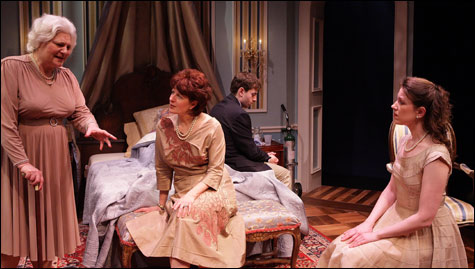
THREE TALL WOMEN: Anne Scurria, Paula Plum, and Liz Hayes aren’t tall, but no matter. |
Edward Albee’s Three Tall Women are really one tall woman, and she’s a tall order: the playwright’s imperious adoptive mother in triplicate, each part as sour on the others as on the gay son who is a silent presence in the play. For Albee, the 1994 Pulitzer-winning work was both an “exorcism” and a comeback — his first play to be critically embraced since Seascape, which had won the Pulitzer in 1975. Twenty years is a long time to wait while an artist wanders in the wilderness, waspish, embittered, and producing the likes of The Lady from Dubuque and a conceited adaptation of Lolita. But the precise and elegiac Three Tall Women was worth it. So is the elegant but tender Lyric Stage Company of Boston revival (through April 26), to my recollection the first Boston production of the work since the national tour passed through town in the mid 1990s.
As Robert Brustein pointed out when the play debuted, Three Tall Women owes a debt to Krapp’s Last Tape, in which another feisty oldster coming to an end looks back with a mix of defiance and regret on younger selves not yet disillusioned by sexuality or bruised by mortality. But the once-statuesque patrician of Three Tall Women doesn’t have an apparatus; she has factotums who at intermission morph into doppelgänger. Act one finds the cryptically identified A, afflicted by age, pain, and Alzheimer’s, holding court as best she can in an opulently appointed bed chamber. She is attended by B, a middle-aged caregiver, and the twentysomething C, who has been dispatched by A’s lawyer to investigate some misplaced documents and unpaid bills. Alternately cackling and crying, ordering and beseeching, railing and remembering, A tenaciously tries to hold onto a humanity some might say was piddling in the first place. Prejudiced, paranoid, and puling, she is not an easy woman to like — though B, acutely possessed of the Beckett-coined knowledge that we give birth astride a grave, is more sympathetic than the judgmental, youth-blinkered C.

What’s remarkable is that Albee, applying his linguistic gifts to the template of this difficult woman, creates a portrait that’s both effectively existential and painfully specific. A is not only a woman of a certain advanced age — she is a woman of a certain era and class, both armed and armored with her oft-told tales of youthful allurement, a prominent match, mutual infidelities among the jodhpur set, and the long-ago night when, naked and tipsy, she was on the receiving end of a diamond bracelet presented on an erect “pee-pee.” “I can’t remember what I can’t remember,” she whimpers at one point. But when the fog lifts, she remembers plenty of the journey that B describes as “downhill from 16 on” but that is so difficult to allow to end. In the play’s final moments, cessation is declared a blessing, indeed the greatest one. But it is as a sheer survivor that Albee admires this haughty, controlling woman he could not love.
Three Tall Women is so exactingly written that a director does best to get out of its way and let it humanely unfold. Spiro Veloudos does so at the Lyric, where the atmosphere of insular gentility reflected in Cristina Todesco’s set, a mosaic of parquet and wallpaper and rich fabrics, is picked up in Peter Bayne’s tasteful yet plaintive original music. Neither does the director flinch from the first act’s portrayal of age in all its agonizing oppressiveness. Each sniping, helpless journey from upholstered chair to canopied bed or off-stage bath is painstakingly portrayed as the whine-inducing struggle it is. One is relieved in the second act, when the 90-year-old A has at least retreated from that final horizon sufficiently to perambulate on a cane, doing fierce if hardly humorless battle with her earlier manifestations, the youngest of whom flatly refuses to become her.
This is not, on the face of it, an ideally cast production. Its three women are not particularly tall, and neither do they resemble one another. As the moribund A, Trinity Repertory Company stalwart Anne Scurria, who is in her 50s, is earthy rather than patrician. But what a sly, terrific actress she is, whether turning on a dime from grim amusement to senile tears or sharing a conspiratorial joke with a younger self. And here she’s teamed with the sublime Paula Plum, whose first-act B is a little rumpled yet razor-sharp, evolving in act two into a perfectly put-together jaded matron of the mid 20th century. If Liz Hayes, as the callous C, isn’t quite in their league, neither is her role. She does bring to the 26-year-old “good girl” with a wild streak a jubilant innocence teetering on regret that’s reminiscent of Emily in Our Town, but she misses the calculation already nascent in the character. Dan Kerrigan is the Albee stand-in, frozen at 18.